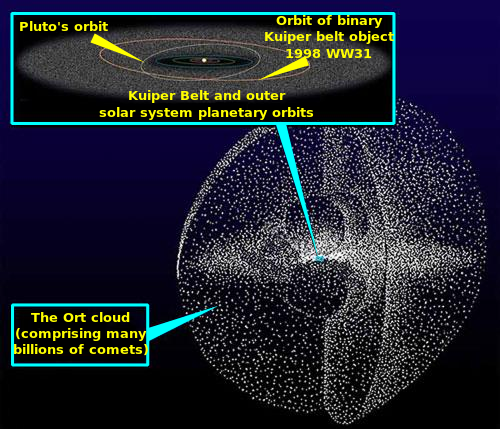December 9, 2014 weblog
Researchers look at Oort cloud asteroids

Sky & Telescope reports on "A fresh look at a nagging problem—asteroids moving in comet-like orbits" where the research "concludes that asteroids must make up about 4 percent of the vast, distant Oort Cloud of comets." Four researchers wrote that the usual picture of the Oort cloud as a collection of icy comets in the outer reaches of the solar system is incomplete. "We use simulations of the formation of the Oort cloud to show that ~4% of the small bodies in the Oort cloud should have formed within 2.5 au of the Sun, and hence be ice-free rock-iron bodies. If we assume these Oort cloud asteroids have the same size distribution as their cometary counterparts, the Large Synoptic Survey Telescope should find roughly a dozen Oort cloud asteroids during ten years of operations."
Andrew Shannon, Alan Jackson, Dimitri Veras and Mark Wyatt wrote about their research, "Eight billion asteroids in the Oort cloud." The authors are from Cambridge, Arizona State University and University of Warwick. To address the question of how common asteroids should be in the Oort cloud, they said they performed simulations of the Oort cloud's formation, "considering small bodies starting with dynamically cold orbits with semimajor axes from 0.5au to 50 au."
Kelly Beatty, Sky & Telescope senior contributing editor, talked about what the researchers set out to explore. They have taken "a fresh look at what-went-where in the early solar system." Their computer simulations, accepted for publication in Monthly Notices of the Royal Astronomical Society, confirmed that "lots of rocky bodies originally within 2½ astronomical units of the Sun should be lurking among the Oort Cloud's half trillion comets."
Shannon and co-authors found that Oort cloud asteroids are a minority, perhaps 4 percent of all the bodies out there, said Beatty. The number may seem small "but that's still 8 billion objects (eerily matching the Weissman-Levison estimate), totaling perhaps a third of Earth's mass," Beatty added.
Anything for us to worry about? On the one hand, said the study, Oort cloud asteroids could be of particular concern as impact hazards: their high mass density, high impact velocity, and low visibility make them difficult to detect and to divert or destroy. In the Discussion section of the paper, though, they said that "The rarity of Oort cloud asteroids means that Earth impacts of asteroids from the Oort cloud are quite unlikely to be a threat on human timescales. From our rate estimates, we find they should produce globally catastrophic collisions around once per Gigayear, and locally destructive impacts every million years. Thus although evidence of such occurrences may be found in the geologic record, they are not a pressing concern for the immediate future."
Marcus Woo, writing in Wired, meanwhile, wrote that there's a thin line, as researchers are learning, between comets and asteroids. "Traditionally, comets and asteroids belong to two distinct categories," said Woo. "In one corner, you have icy comets with long, wispy tails of gas and dust. In the other, you have dim, rocky asteroids in orbit between Mars and Jupiter." Some astronomers find the distinction is not so clear, with asteroids found that look like comets and vice versa. They have witnessed discovery after discovery, said planetary scientist Henry Hsieh of Academia Sinica in Taiwan in Woo's article, blurring the line. Hsieh said astronomers are coming around to the idea that asteroids and comets are at two ends of a range of objects.
More information: Eight billion asteroids in the Oort cloud, Monthly Notices of the Royal Astronomical Society, mnras.oxfordjournals.org/conte … /446/2/2059.abstract . On Arxiv: arxiv.org/abs/1410.7403
Abstract
The Oort cloud is usually thought of as a collection of icy comets inhabiting the outer reaches of the Solar system, but this picture is incomplete. We use simulations of the formation of the Oort cloud to show that ∼4 per cent of the small bodies in the Oort cloud should have formed within 2.5 au of the Sun, and hence be ice-free rock-iron bodies. If we assume that these Oort cloud asteroids have the same size distribution as their cometary counterparts, the Large Synoptic Survey Telescope should find roughly a dozen Oort cloud asteroids during 10 years of operations. Measurement of the asteroid fraction within the Oort cloud can serve as an excellent test of the Solar system's formation and dynamical history. Oort cloud asteroids could be of particular concern as impact hazards as their high mass density, high impact velocity, and low visibility make them both hard to detect and hard to divert or destroy. However, they should be a rare class of object, and we estimate globally catastrophic collisions should only occur about once per billion years.
Journal information: Monthly Notices of the Royal Astronomical Society , arXiv
© 2014 Phys.org





















